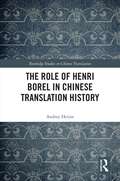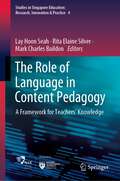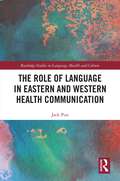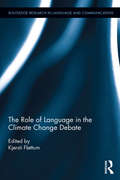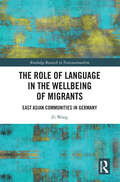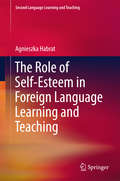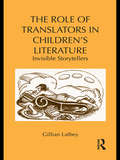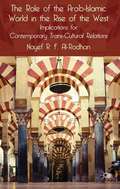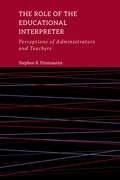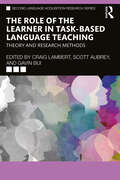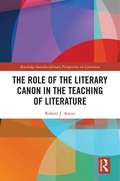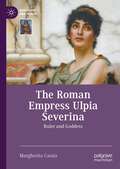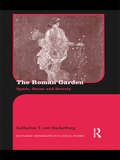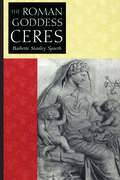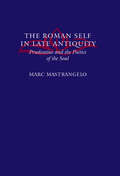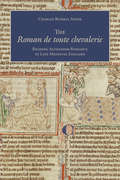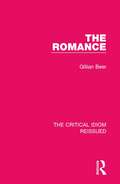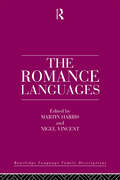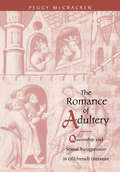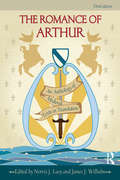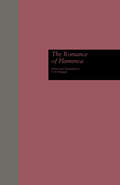- Table View
- List View
The Role of Henri Borel in Chinese Translation History (Routledge Studies in Chinese Translation)
by Audrey HeijnsAgainst the historical background of Chinese translation in the West and the emergence of several prominent European translators of China, this book examines the role of a translator in terms of cross-cultural communication, the image of the foreign culture in the minds of the target audience, and the influence of their translations on the target culture. With the focus on the career and output of the Dutch translator Henri Borel (1869–1933), this study investigates different aspects of the role of translator. The investigation is carried out by analysing texts and probing the achievements and contributions of the translator, underpinned by documents from the National Archives and the Literature Museum in the Hague, the Netherlands. Based on the findings derived from this study, advice is offered to those now involved in the promotion and translation of Chinese culture and literature. It will make an important contribution to the burgeoning history of Chinese translation. This book will be of interest to anyone with an interest or background in the translation history of China, the history of sinology in the West, and the role of translators.
The Role of Language Teacher Associations in Professional Development (Second Language Learning and Teaching)
by Christine Coombe Aymen Elsheikh Okon EffiongProviding a timely and much-needed resource on LTAs, the book helps readers recognize the importance and nature of teachers’ professional development, while also contributing to the process of educational change. In order to achieve a suitable level of educational and policy change, a research base for LTAs is called for. This book represents a step in the right direction, introducing readers to essential research on the central role of LTAs in language teachers’ development. Although pre-service and in-service education programs, to be found at government and/or private institutions, are of great value, it is impossible to prepare teachers for all the challenges they will face throughout their careers. In response, many professional associations also provide a wide range of professional development activities for their teacher members. The book will be of interest to language teachers, graduate students, teacher educators and researchers, educational leaders and policymakers, as well as teacher associations.
The Role of Language in Content Pedagogy: A Framework for Teachers’ Knowledge (Studies in Singapore Education: Research, Innovation & Practice #4)
by Rita Elaine Silver Lay Hoon Seah Mark Charles BaildonThis book explores the importance of language in content learning. It focuses on teachers’ roles, knowledge and understanding of language in school contexts (including academic language and disciplinary languages) to support students. It examines teachers' language-related knowledge base for content teaching, which include teachers' knowledge of and about language, knowledge of (their) students and their pedagogical knowledge. This book also explores how teachers’ knowledge of language, students and content are linked as part of a larger pedagogical content knowledge, which includes knowledge of the role of language in content learning. As well, it further considers literacy (and literacies) as part of this examination of teachers’ knowledge of language.
The Role of Language in Eastern and Western Health Communication (Routledge Studies in Language, Health and Culture)
by Jack PunJack Pun’s book offers up the latest research in a variety of health communication settings to highlight the cultural differences between the East and the West. It focuses on the various clinical strands in health communication such as doctor-patient interactions, nurse handover, and cross-disciplinary communication to provide a broad, comprehensive overview of the complexity and heterogeneity of health communication in the Chinese context, which is gradually moving beyond a preference for Western-based models to one that considers the local culture in understanding and interpreting medical encounters. The content highlights the cultural difference between the East and the West, and focuses on how traditional Chinese values underpin the nature of clinical communication in various clinical settings and how Chinese patients and practitioners conduct themselves during medical encounters. The book also covers various topics that are unique to Chinese contexts such as the use of traditional Chinese medicine in primary care, and how clinicians translate Western models of communication when working in Chinese contexts with Chinese patients. This volume will appeal to researchers working in health communication in both the East and West as well as clinicians interested in understanding what makes effective communication with multicultural patient cohorts.
The Role of Language in the Climate Change Debate (Routledge Research in Language and Communication)
by Kjersti FlottumThis volume takes a distinctive look at the climate change debate, already widely studied across a number of disciplines, by exploring the myriad linguistic and discursive perspectives and approaches at play in the climate change debate as represented in a variety of genres. The book focuses on key linguistic themes, including linguistic polyphony, lexical choices, metaphors, narration, and framing, and uses examples from diverse forms of media, including scientific documents, policy reports, op-eds, and blogs, to shed light on how information and knowledge on climate change can be represented, disseminated, and interpreted and in turn, how they can inform further discussion and debate. Featuring contributions from a global team of researchers and drawing on a broad array of linguistic approaches, this collection offers an extensive overview of the role of language in the climate change debate for graduate students, researchers, and scholars in applied linguistics, environmental communication, discourse analysis, political science, climatology, and media studies.
The Role of Language in the Wellbeing of Migrants: East Asian Communities in Germany (Routledge Research in Transnationalism)
by Zi WangThis book examines the correlations between language behaviour and happiness amongst communities of migrants, and addresses the overarching question of whether language can affect wellbeing. Zi Wang takes an innovative look at migration and wellbeing by examining the crucial role language – a quintessential part of the international migration experience – plays in migrants’ wellbeing. Drawing on case studies from Chinese and Japanese-speaking communities in Germany, as well as secondary survey data on the general migrant population, Wang shows that proficiency in both host country and heritage languages is associated with robust enhancements of migrants’ subjective wellbeing. He argues that acquisition of host country language and the preservation and promotion of heritage culture should not be portrayed as a zero-sum game by stakeholders in host societies. Instead, we ought to consider the unique experiences of migrants in order to fully comprehend the ways in which they experience, evaluate, and pursue happiness in a host society. Presenting a novel approach to the study of migrants’ wellbeing, this book will be of interest to scholars and students of area studies, education, international migration, sociology of language, and wellbeing research.
The Role of Self-Esteem in Foreign Language Learning and Teaching (Second Language Learning and Teaching)
by Agnieszka HabratThis book demonstrates how foreign language self-esteem (FLSE) affects foreign language (L2) learning and teaching, and how it fluctuates with growing proficiency. Further, it explains the interaction between FLSE and a range of factors of recognized importance in second language acquisition (SLA). The theoretical part of the book presents the main pillars of self-esteem as well as its notable influence on psychological functioning and learning, with special emphasis being placed on L2 learning. In turn, the empirical part presents the findings of a study that explored the trajectory and behavioural outcomes of FLSE across three stages of education. The book closes by outlining future research directions, as well as some pedagogical implications. In particular, the findings of the study can be employed in teaching English as a foreign or second language by helping instructors understand the significance of learners’ individual differences.
The Role of Translators in Children’s Literature: Invisible Storytellers (Children's Literature And Culture Ser. #71)
by Gillian LatheyThis book offers a historical analysis of key classical translated works for children, such as writings by Hans Christian Andersen and Grimms’ tales. Translations dominate the earliest history of texts written for children in English, and stories translated from other languages have continued to shape its course to the present day. Lathey traces the role of the translator and the impact of translations on the history of English-language children’s literature from the ninth century onwards. Discussions of popular texts in each era reveal fluctuations in the reception of translated children’s texts, as well as instances of cultural mediation by translators and editors. Abridgement, adaptation, and alteration by translators have often been viewed in a negative light, yet a closer examination of historical translators’ prefaces reveals a far more varied picture than that of faceless conduits or wilful censors. From William Caxton’s dedication of his translated History of Jason to young Prince Edward in 1477 (‘to thentent/he may begynne to lerne read Englissh’), to Edgar Taylor’s justification of the first translation into English of Grimms’ tales as a means of promoting children’s imaginations in an age of reason, translators have recorded in prefaces and other writings their didactic, religious, aesthetic, financial, and even political purposes for translating children’s texts.
The Role of Unexpected Events in Stories: J. Bruner’s and C. Feldman’s Florentine Seminar (SpringerBriefs in Psychology)
by Andrea SmortiThis book stems primarily from the intention to make public the seminar entitled "Narratives and Cultural Psychology" held by J. Bruner and C. Feldman in May 2000 in Florence. This seminar represents the point of view of these two authors, at an important moment in their scientific and human careers, on two themes: narratives and interpretative communities.The central concept on which this book works is the Aristotelian concept of peripeteia which, born in the world of art, is developed by Bruner in the field of cognitive and cultural psychology and by Feldman in the concept of interpretative community.Thus the first purpose of this book is to analyze the role and usefulness of this concept in the study of the world of stories and cultureThe second aim of this book is to explain, clarify and comment on the concept, the theoretical assumptions and the key words used by the two authors, while also exploring the issues addressed. In this way, the author wanted to reflect on what contribution this seminar offers today to the theme of narratives and cultural psychology and what the future prospects might be.This book is aimed at students and scholars interested in exploring the role that stories play in human culture.
The Role of the Arab-Islamic World in the Rise of the West
by Nayef R. F. Al-RodhanThis book takes a fascinating look at the role of the Arab-Islamic world in the rise of the West. It examines the cultural transmission of ideas and institutions in a number of key areas, including science, philosophy, humanism, law, finance, commerce, as well as the Arab-Islamic world's overall impact on the Reformation and the Renaissance.
The Role of the Educational Interpreter: Perceptions of Administrators and Teachers (The Interpreter Education Series #11)
by Stephen B. FitzmauriceWhile educational interpreting has been studied for decades, the research has historically focused on the tasks educational interpreters are engaged in during their work day. In The Role of the Educational Interpreter, Stephen B. Fitzmaurice takes a new approach using role theory to examine how administrators and teachers perceive the role and work of educational (K–12) interpreters. Through a series of qualitative interviews and quantitative questionnaires with district administrators, school administrators, general education teachers, and teachers of the deaf, Fitzmaurice documents their perceptions of educational interpreters. Findings from the data reveal the perceptions of administrators and teachers set the stage for role ambiguity, role conflicts, and subsequent role overload for educational interpreters. Fitzmaurice elaborates on the implications of the research, and also provides concrete recommendations for researchers and practitioners, including an emphasis on the importance of involving the Deaf community in this work. This volume aims to offer clarity on the role of the educational interpreter, and dispel the confusion and conflicts created by divergent perspectives. A shared understanding of the role of the educational interpreter will allow administrators, teachers, and interpreters to work collaboratively to improve educational outcomes for deaf students.
The Role of the Learner in Task-Based Language Teaching: Theory and Research Methods (Second Language Acquisition Research Series)
by Craig Lambert Scott Aubrey Gavin BuiThis comprehensive, forward-looking text is the first holistic research overview and practical methods guide for researching the role that affective and conative factors play in second language learners’ task performance and language acquisition. It provides a long overdue update on the role of the learner in task-based language teaching (TBLT). The book brings together theoretical background and major constructs, established and innovative methodological and technological tools, cutting-edge findings, and illuminating suggestions for future work. A group of expert scholars from around the world synthesize the state of the art, detail how to design and conduct empirical studies, and authoritatively set the agenda for future work in this critical, emerging area of language learning and instructional design. With a variety of helpful features like suggested research, discussion questions, and recommended further readings, this will be an invaluable resource to advanced students and researchers of second language acquisition, applied linguistics, psychology, education, and related areas.
The Role of the Literary Canon in the Teaching of Literature (Routledge Interdisciplinary Perspectives on Literature)
by Robert AstonThis book investigates the role of the idea of the literary canon in the teaching of literature, especially in colleges and secondary schools in the United States. Before the term "canon" was widely used in literary studies, which occurred in the second half of 20th century when the canon was first seriously viewed as politically and culturally problematic, the idea that some literary texts were more worthy of being studied than others existed since the beginning of the discipline of the teaching of literature in the 1800s. The concept of the canon, however, extends as far back as to Ancient Greece and its meaning has evolved over time. Thus, this book charts the changing meaning of the idea of the literary canon, examining its influence specifically in the teaching of literature from the beginning of the field to the 21st century. To explain how the literary canon and the teaching of literature have changed over time and continue to change, this book constructs a theory of canon formation based on the ideas of Michel Foucault and the assemblage theory of Manuel DeLanda, illustrating that the literary canon, while frequently contested, is integral to the teaching of literature yet changes as the teaching of literature changes.
The Roman Empress Ulpia Severina: Ruler and Goddess (Queenship and Power)
by Margherita CassiaOf the twelve Augustae who lived during the fifty years of the so-called “military anarchy” (235-284 A.D.), Ulpia Severina, wife of the “Illyrian” emperor Aurelian (270-275 AD), is certainly one of the most enigmatic and less known. The book focuses on Ulpia Severina, who, even though never mentioned by name in literary sources, has been studied almost exclusively from the perspective of the numerous coins issued in her name and is the subject of many interesting honorific inscriptions that had not been thoroughly examined or adequately valued until this study. This exceptional situation, represented by the sole presence of Ulpia Severina on the throne of Rome, deserves more attention than it has received. The pages of the university history textbooks dedicated to the reconstruction of a fifty-year phase of Roman-imperial history must be, if not rewritten, at least integrated in order to give the deserved space to this empress and, therefore, to the so-called “interregnum,” which lasted at least two months, between the death of Aurelian and the advent of emperor Tacitus.
The Roman Garden: Space, Sense, and Society (Routledge Monographs in Classical Studies)
by Katharine T. von StackelbergThis innovative book is the first comprehensive study of ancient Roman gardens to combine literary and archaeological evidence with contemporary space theory. It applies a variety of interdisciplinary methods including access analysis, literary and gender theory to offer a critical framework for interpreting Roman gardens as physical sites and representations. The Roman Garden: Space, Sense, and Society examines how the garden functioned as a conceptual, sensual and physical space in Roman society, and its use as a vehicle of cultural communication. Readers will learn not only about the content and development of the Roman garden, but also how they promoted memories and experiences. It includes a detailed original analysis of garden terminology and concludes with three case studies on the House of Octavius Quartio and the House of the Menander in Pompeii, Pliny’s Tuscan garden, and Caligula’s Horti Lamiani in Rome. Providing both an introduction and an advanced analysis, this is a valuable and original addition to the growing scholarship in ancient gardens and will complement courses on Roman history, landscape archaeology and environmental history.
The Roman Goddess Ceres
by Barbette Stanley SpaethA thematic study of the Roman goddess of agriculture as represented in ancient culture from the prehistoric period to the Late Roman Empire.Interest in goddess worship is growing in contemporary society, as women seek models for feminine spirituality and wholeness. New cults are developing around ancient goddesses from many cultures, although their modern adherents often envision and interpret the goddesses very differently than their original worshippers did.In this thematic study of the Roman goddess Ceres, Barbette Spaeth explores the rich complexity of meanings and functions that grew up around the goddess from the prehistoric period to the Late Roman Empire. In particular, she examines two major concepts, fertility and liminality, and two social categories, the plebs and women, which were inextricably linked with Ceres in the Roman mind. Spaeth then analyzes an image of the goddess in a relief of the Ara Pacis, an important state monument of the Augustan period, showing how it incorporates all these varied roles and associations of Ceres. This interpretation represents a new contribution to art history. With its use of literary, epigraphical, numismatic, artistic, and archaeological evidence, The Roman Goddess Ceres presents a more encompassing view of the goddess than was previously available. It will be important reading for all students of Classics, as well as for a general audience interested in New Age, feminist, or pagan spirituality.
The Roman Paratext
by Laura JansenWhat is a paratext, and where can we find it in a Roman text? What kind of space does a paratext occupy, and how does this space relate to the text and its contexts? How do we interpret Roman texts 'paratextually'? And what does this approach suggest about a work's original modes of plotting meaning, or the assumptions that underpin our own interpretation? These questions are central to the conceptual and practical concerns of the volume, which offers a synoptic study of Roman paratextuality and its exegesis within the broad sphere of Roman studies. Its contributions, which span literary, epigraphic and visual culture, focus on a wide variety of paratextual features - e. g. titles and inter-titles, prefaces, indices, inscriptions, closing statements, decorative and formalistic details - and other paratextual phenomena, such as the frames that can be plotted at various intersections of a text's formal organization.
The Roman Self in Late Antiquity: Prudentius and the Poetics of the Soul
by Marc MastrangeloThe Roman Self in Late Antiquity for the first time situates Prudentius within a broad intellectual, political, and literary context of fourth-century Rome. As Marc Mastrangelo convincingly demonstrates, the late-fourth-century poet drew on both pagan and Christian intellectual traditions—especially Platonism, Vergilian epic poetics, and biblical exegesis—to define a new vision of the self for the newly Christian Roman Empire. Mastrangelo proposes an original theory of Prudentius's allegorical poetry and establishes Prudentius as a successor to Vergil. Employing recent approaches to typology and biblical exegesis as well as the most current theories of allusion and intertextuality in Latin poetry, he interprets the meaning and influence of Prudentius's work and positions the poet as a vital author for the transmission of the classical tradition to the early modern period. This provocative study challenges the view that poetry in the fourth century played a subordinate role to patristic prose in forging Christian Roman identity. It seeks to restore poetry to its rightful place as a crucial source for interpreting the rich cultural and intellectual life of the era.
The Roman de toute chevalerie: Reading Alexander Romance in Late Medieval England
by Charles Russell StoneThe medieval reception of Alexander the Great inspired a complicated literary corpus not simply because it involved so many source-texts and languages, but because it incorporated such diverse perspectives on the conqueror. Beginning with a discussion of the evolution of this corpus, this book examines the manuscripts, readership, and historical contexts of the earliest surviving Alexander romance in England, Thomas de Kent’s Anglo-Norman Roman de toute chevalerie. To shed light on the origins and treatment of this romance, Charles Russell Stone reads each manuscript within the contexts of its production, scribal interpolations, and patronage and readership in the thirteenth and fourteenth centuries. While Thomas recalls a range of attitudes towards his protagonist in the late twelfth century, when the recovery of classical histories and composition of vernacular romance informed conflicting attitudes towards Alexander’s legacy, scribes and readers of his poem appropriated it as a continuing commentary on power, politics, and the relevance of the Alexander legend in their own time. Each of the three major manuscripts of Thomas’s poem thus offers a unique text informed by unique literary and political contexts, which this book situates within the ongoing debate over Alexander’s reception as a paradigm of imperial authority or failure in late medieval England.
The Romance (The Critical Idiom Reissued #9)
by Gillian BeerFirst published in 1970, this work provides an overview of the Romance from the medieval period to the 20th century and tracks how the genre has changed with time, including its interaction with other forms of literature such as gothic novels, realism and science fiction. It explores a myriad of writers including Chaucer, Sidney, Tennyson, Shelley, Meredith and Keats and analyses key texts such as Don Quixote by Cervantes and Kubla Khan by Coleridge. This book will be of interest to those studying Romantic literature.
The Romance Between Greece and the East
by Tim Whitmarsh Stuart ThomsonThe contact zones between the Greco-Roman world and the Near East represent one of the most exciting and fast-moving areas of ancient-world studies. This new collection of essays, by world-renowned experts (and some new voices) in classical, Jewish, Egyptian, Mesopotamian and Persian literature, focuses specifically on prose fiction, or 'the ancient novel'. Twenty chapters either offer fresh readings - from an intercultural perspective - of familiar texts (such as the biblical Esther and Ecclesiastes, Xenophon of Ephesus' Ephesian Story and Dictys of Crete's Journal), or introduce material that may be new to many readers: from demotic Egyptian papyri through old Avestan hymns to a Turkic translation of the Life of Aesop. The volume also considers issues of methodology and the history of scholarship on the topic. A concluding section deals with the question of how narratives, patterns and motifs may have come to be transmitted between cultures.
The Romance Languages: Volume 1, Structures (Routledge Language Family Series)
by Nigel Vincent Martin HarrisAvailable again, this book discusses nine Romance languages in context of their common Latin origins and then in individual studies. The final chapter is devoted to Romance-based Creole languages; a genuine innovation in a work of this kind.
The Romance of Adultery
by Peggy MccrackenPeggy McCracken offers a feminist historicist reading of Guenevere, Iseut, and other adulterous queens of Old French literature, and situates romance narratives about queens and their lovers within the broader cultural debate about the institution of queenship in twelfth- and thirteenth-century France.Moving among a wide selection of narratives that recount the stories of queens and their lovers, McCracken explores the ways adultery is appropriated into the political structure of romance. McCracken examines the symbolic meanings and uses of the queen's body in both romance and the historical institutions of monarchy and points toward the ways medieval romance contributed to the evolving definition of royal sovereignty as exclusively male.
The Romance of Arthur: An Anthology of Medieval Texts in Translation
by Norris J. Lacy James J. WilhelmThe Romance of Arthur, James J. Wilhelm's classic anthology of Arthurian literature, is an essential text for students of the medieval Romance tradition. This fully updated third edition presents a comprehensive reader, mapping the course of Arthurian literature, and is expanded to cover: key authors such as Chrétien de Troyes and Thomas of Britain, as well as Arthurian texts by women and more obscure sources for Arthurian romance extensive coverage of key themes and characters in the tradition a wide geographical range of texts including translations from Latin, French, German, Spanish, Welsh, Middle English, and Italian sources a broad chronological range of texts, encompassing nearly a thousand years of Arthurian romance. Norris J. Lacy builds on the book's source material, presenting readers with a clear introduction to many accessible modern-spelling versions of Arthurian texts. The extracts are presented in a new reader-friendly format with detailed suggestions for further reading and illustrations of key places, figures, and scenes. The Romance of Arthur provides an excellent introduction and an extensive resource for both students and scholars of Arthurian literature.
The Romance of Flamenca (Library of Medieval Literature #Vol. 101a)
by E. D. BlodgettFirst published in 1995. Routledge is an imprint of Taylor & Francis, an informa company.
